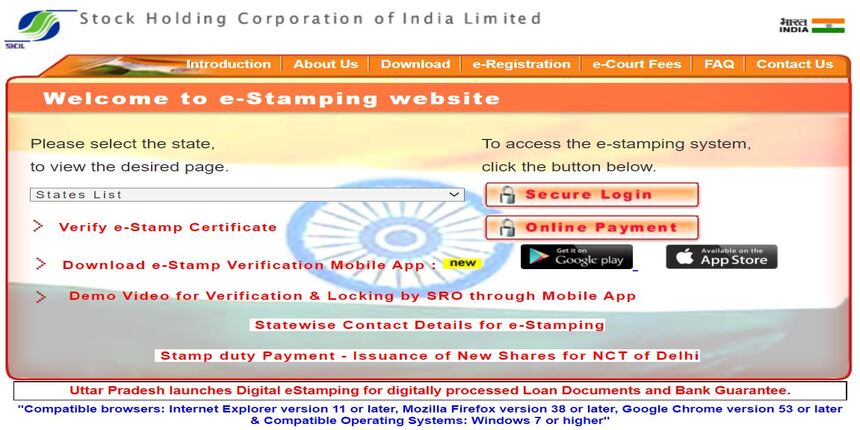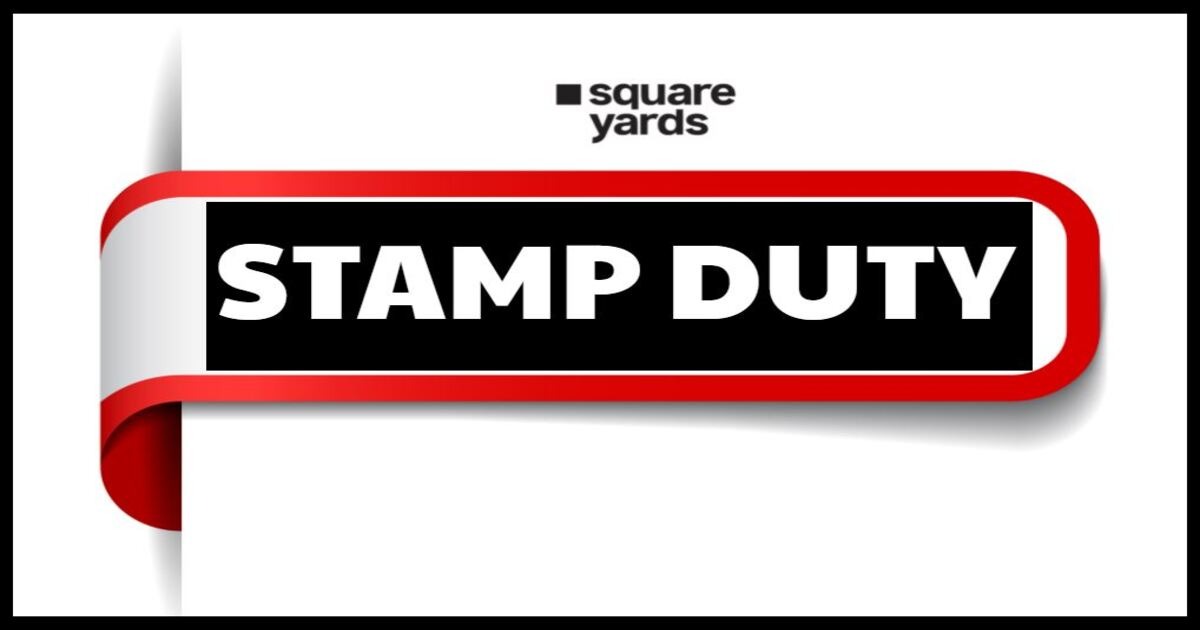A buyer for each and every property transaction is supposed to pay the stamp duty, in order to complete the settlement. Earlier, it was made necessary for the purchaser to be present in the registrar’s office to complete their property registration. Now, they have a facility to complete the same through an online portal. The process of completing the e-stamp registration through the online portal is called e-stamping or in other words online stamping.
In this article, we shed light on all the aspects related to E-stamping.
Let’s begin!
Benefits of E-Stamping
- It helps in generating the e-stamping certificate within no time.
- The E-stamping certificate has its own UIN which is why there is no way that it can get altered.
- You can always check the authenticity of this certificate through the inquiry guide provided to you.
- You need not require any kind of denomination for the same.
- Easily pay your stamp duty through this portal online.
- You can get a printout at your own convenience.
- They have their known centre authorised for such collections that help in issuing the certificates to its users.
Authorised Collection Centres (ACC)
- ACC acts as a mediator between the client and the Stock Holding Corporation India limited.
- This is basically an agency that has been assigned through the Stock Holding Corporation India Limited.
- All the organised banks & post offices can be known as Authorised Collection Centres in India.
Stamp Duty Online Payment for E-stamping
These is the step-by-step method that can easily help you in paying your stamp duty for e-stamping:
Step1: In case you are new to the SHCIL portal, simply tap on the “Register Now” tab and proceed further.
Step2: Fill in all the necessary information.
Step3: Select your User ID and password along with filing the security questions asked, next fill up your bank details and move forward.
Step4: Once you are done selecting your User ID and password, you can log in using the same.
Step5: Choose the state from the given drop down menu for which you are required to pay the stamp duty.
E.g.: If it’s for Uttar Pradesh, you will select the same from the drop-down and then further choose the ‘Nearest SHCIL Branch’ after which you are required to fill in some details such as:
- First Party Name
- Second Party Name
- Article Number
- The name of the person who paid the stamp duty.
- The amount of the stamp duty
All the above details need to be filed accurately in order to generate your ‘Online Reference Acknowledgement Number’.
This is done to pay any kind of amount through modes of Net Banking, RTGS, Debit Card, EFT, and NEFT.
Step 6: A citizen is then required to print this ‘Online Reference Acknowledgment Number’ and pay a visit to his/her most accessible SHCIL Branch to get its final copy of the e-stamp certificate.
All About Stock Holding Corporation India Limited
Meaning of SHCIL
Stock Holding Corporation India Limited is India’s prime deposit participant, which was established as part of Public Ltd. Company in the year 1986. This is basically an agency that has been appointed by the government of India to record all the transactions made online.
What is SHCIL E-stamping?
Stock Holding Corporation India Limited is known to be the only agency that the government has appointed for records for all the transactions made.
Responsibilities of SHCIL
This central body kept for recording is responsible for the following things:
- E-stamp egistration process for the users
- Administering the payments made
- Applications made for e-stamping
- Maintenance
Stamp Duty and Registration Charges in Other States
| Maharashtra | Stamp Duty in Maharashtra |
| Gujarat | Stamp Duty in Gujarat |
| Uttar Pradesh | Stamp Duty in Uttar Pradesh |
| West Bengal | Stamp Duty in West Bengal |
| Delhi | Stamp Duty in Delhi |
| Haryana | Stamp Duty in Haryana |
| Rajasthan | Stamp Duty in Rajasthan |
| Bangalore | Stamp Duty in Bangalore |
| Gurgaon | Stamp Duty in Gurgaon |
| Pune | Stamp Duty in Pune |
| Punjab | Stamp Duty in Punjab |
| Odisha | Stamp Duty in Odisha |
Different Modes of Payment for Stamp Duty of E-stamping
There are various ways through which an individual can pay its stamp duty amount. These are stated as follows:
- Cash
- Cheque
- Pay Order
- NEFT
- Demand Draft
- RTGS
- Account to Account Transfer
How to Verify the Certificate for E-Stamping?
“Step 1: Visit the homepage of E-stamping.

Step 2: The second option that you see on your screen says ‘Verify e-stamp’
Step 3: Click on the same which will further ask you to enter the following information:
- State
- Certificate Number
- Type for your stamp duty
- Date when the certificate was issued
- Your Session Id
Step 4: After filling in all the above information, finally click on ‘Verify’.”
Verification Certificate for E-Stamping through Mobile-App
Verification for E-stamping through Mobile-App involves simple steps that are listed as follows:
Step 1: Download the verification app on your mobile phone through your play store or App Store.
Step 2: Now, you need to scan the e-stamp or else manually verify the same.
For Scan Verification
Step 1: Scan the QR code provided to you to get your verification certificate. This helps you in accessing all the necessary information.
(You need to know that the stamp verification certificate does not work in case the certificate was generated before 13th February in the year 2019.
For Manual Verification
Step 1: To get your verification certificate manually, simply tap on the ‘Manual Button’.
Stepc2: Select the state's name for which you require the certificate.
Step 3: Further, fill in the following information:
- Certificate Number
- The date on which the certificate was issued to you.
- And finally, tap on the ‘Verify’ button.
Once, you are through with all the above-mentioned steps you will be delivered with the following details:
- Certificate Number
- The date on which the certificate was issued to you.
- Amount reference
- Information regarding the purchase.
- The entire description of the document.
- Unique Document Reference.
- First Party Name
- Second Party Name
- The amount that needs to be paid as stamp duty.
- The name of the client that has paid the stamp duty.
- Consideration Price
Important Key-Pointers for E-stamping
- You need to keep a copy of your verification certificate safe. As there will be no duplicate copy that will get issued to you.
- In case there is a refund that you want to apply for on your e-stamp after the cancellation, it can be done only if you visit the Stock Holding Corporation India Limited office.
- Also, in Maharashtra, the only way that you can pay your e-stamp charge is through the online method. Visiting the Stock Holding Corporation India Limited office will not help in any way.
But yes, it can be done through an ‘Electronic Secured Bank Treasury Receipt’ also known as BTR- which is another service provided to you for your online payment method.
States that include E-stamping Services
- Bihar
- Chandigarh
- Assam
- Andaman & Nicobar Islands
- Chhattisgarh
- Andhra Pradesh
- Delhi
- Dadra & Nagar Haveli
- Gujarat
- Daman & Diu
- Odisha
- Punjab
- Himachal Pradesh
- Uttarakhand
- Jharkhand
- Tripura
- Karnataka
- Tamil Nadu
- Jammu & Kashmir
- Uttar Pradesh
- Puducherry
- Rajasthan
Get Your Documents E-Stamped
Step 1: Go on the official portal of SHCIL which is stockholding[dot]com
Step 2: Tap on ‘Product and Services’, next click on ‘E-stamp service’ and then from the drop-down select ‘E-stamping’.
Step 3: Select the state according to preference.
Step 4: Fill in the application that you will be able to find on the homepage itself Under the ‘Download’ section. Simply download the e-stamping form and fill in the necessary information.
Step 5: The last step for you is to fill in the application e-stamping form and pay the necessary amount associated with it.
Please Note: The portal at present will show only those states that have the facility of e-stamping available as mentioned above. It is then advised by the users to make full use of it.
Why Do You Need E-Stamp Paper?
Any sort of transaction made which may include you purchasing a property or selling one involves you paying the stamp duty on property. The payment of stamp duty is done by purchasing a e-stamp paper for your transaction. This paper acts as proof that the payment has been made to the government. It is not necessary for a user to visit the registration office, all you are supposed to do is to download e-stamp paper from the portal.
FAQ's about E-stamping
Q1. What is digital e-stamping?
Digital e-stamping is a procedure that helps in making the payment securely online, that then acts as a legal document for a user. It helps to save both time and money.
Q2. How to download e stamping form?
You will get the application form from the SHCIL portal itself under the ‘Download’ tab. Simply download the form and fill in the necessary information.
Q3. What is a non-judicial stamp paper?
A non-judicial stamp paper is used for transactions that include your affidavits, sale deeds, wills, transferring of immovable properties, etc. You can easily get your hand on this stamp paper by visiting any near stamp vendor.
Q4. How to log in to the e-stamping Portal?
In case you are new to the SHCIL portal, simply tap on the “Register Now” tab and proceed further.
Q5. What is the value of e stamp paper?
The value for e stamp paper has now reduced from INR 9,999 to INR 4,999.




